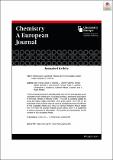Files in this item
N-heterocyclic carbenes reduce and functionalize copper oxide surfaces in one pot
Item metadata
| dc.contributor.author | Veinot, Alex | |
| dc.contributor.author | Al-Rashed, Abrar | |
| dc.contributor.author | Padmos, J. Daniel | |
| dc.contributor.author | Singh, Ishwar | |
| dc.contributor.author | Lee, Dianne S. | |
| dc.contributor.author | Narouz, Mina R. | |
| dc.contributor.author | Lummis, Paul A. | |
| dc.contributor.author | Baddeley, Christopher J. | |
| dc.contributor.author | Crudden, Cathleen Marie | |
| dc.contributor.author | Horton, J. Hugh | |
| dc.date.accessioned | 2021-08-06T23:39:22Z | |
| dc.date.available | 2021-08-06T23:39:22Z | |
| dc.date.issued | 2020-08-07 | |
| dc.identifier | 268707567 | |
| dc.identifier | d3c26e6c-91ba-483f-afa1-4e0eab755443 | |
| dc.identifier | 85089099323 | |
| dc.identifier | 000556302100001 | |
| dc.identifier.citation | Veinot , A , Al-Rashed , A , Padmos , J D , Singh , I , Lee , D S , Narouz , M R , Lummis , P A , Baddeley , C J , Crudden , C M & Horton , J H 2020 , ' N-heterocyclic carbenes reduce and functionalize copper oxide surfaces in one pot ' , Chemistry - A European Journal , vol. Early View . https://doi.org/10.1002/chem.202002308 | en |
| dc.identifier.issn | 0947-6539 | |
| dc.identifier.other | RIS: urn:51B21FBB35A3BC030D8BAB0ED03A4876 | |
| dc.identifier.other | ORCID: /0000-0001-9750-6494/work/78891559 | |
| dc.identifier.uri | https://hdl.handle.net/10023/23736 | |
| dc.description | The Natural Sciences and Engineering Research Council of Canada (NSERC) and the Canada Foundation for Innovation (CFI) are thanked for financial support of this work in terms of operating and equipment grants to CMC and JHH. AJV and MRN thank the Ontario government for OGS fellowships. AJV thanks NSERC for a Vanier Scholarship and also the Walter C. Sumner foundation for additional scholarship support. | en |
| dc.description.abstract | Benzimidazolium hydrogen carbonate salts have been shown to act as N-heterocyclic carbene precursors which can remove oxide from copper oxide surfaces and functionalize the resulting metallic surfaces in a single step. Both the surfaces and the etching products are fully characterized by spectroscopic methods. Analysis of surfaces before and after NHC treatment by X-ray photoelectron spectroscopy demonstrates the complete removal of copper(II) oxide. Using 13C-labelling, we determine that the products of this transformation include a cyclic urea, a ring-opened formamide and a bis-carbene copper(I) complex. These results illustrate the potential of NHCs to functionalize a much broader class of metals, including those prone to oxide treatment, greatly facilitating the preparation of NHC-based films on metals other than gold. | |
| dc.format.extent | 1362765 | |
| dc.language.iso | eng | |
| dc.relation.ispartof | Chemistry - A European Journal | en |
| dc.subject | N-Heterocyclic carbene | en |
| dc.subject | Copper oxide | en |
| dc.subject | Reduction | en |
| dc.subject | Self assembled monolayer | en |
| dc.subject | QD Chemistry | en |
| dc.subject | DAS | en |
| dc.subject.lcc | QD | en |
| dc.title | N-heterocyclic carbenes reduce and functionalize copper oxide surfaces in one pot | en |
| dc.type | Journal article | en |
| dc.contributor.institution | University of St Andrews. School of Chemistry | en |
| dc.contributor.institution | University of St Andrews. EaSTCHEM | en |
| dc.identifier.doi | 10.1002/chem.202002308 | |
| dc.description.status | Peer reviewed | en |
| dc.date.embargoedUntil | 2021-08-07 |
This item appears in the following Collection(s)
Items in the St Andrews Research Repository are protected by copyright, with all rights reserved, unless otherwise indicated.

